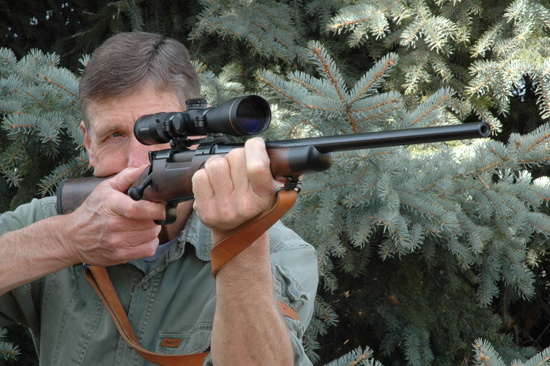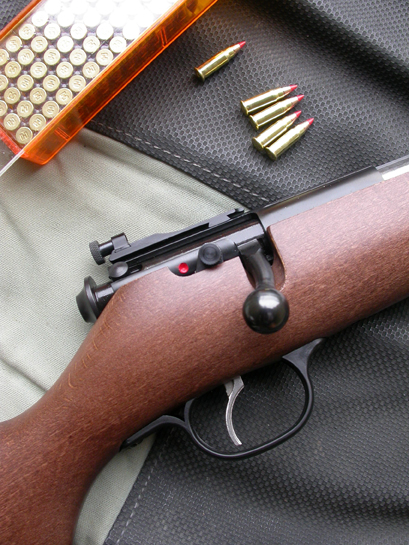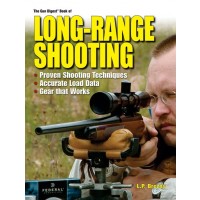

Practice. It’s the way to get good at just about anything. Gun drills can even help you get good at doing the wrong thing.
Lones Wigger, the most decorated Olympic rifleman ever, once told me he practiced gun drills up to four hours a day for the U.S. Army Marksmanship Training Unit.

“More importantly, I practiced the right things. Every shot must be well executed. If you’re too tired of shooting to shoot well, it’s time to quit. A sloppy shot is practice for more sloppy shots,” he said.
You’ve seen people blaze away as if success depended on a high count of empty hulls. AR-15s and autoloading pistols encourage careless shooting – though they’re not responsible for it.
Another accomplished Olympian, Gary Anderson, dry-fired his .22 rifle so much, he reportedly peened the chamber lip to the point a cartridge wouldn’t enter.
“Launching a bullet is a small part of the shooting routine,” he told me. “Most of the important stuff happens first. Where the bullet goes depends on what you do before it’s free of the rifle, or even out of the case. You can become a very good shooter without hearing a bang.”
Position, breathing and trigger squeeze – even follow-through – can all be done in gun drills as easily with an empty rifle as with live ammunition. You learn to call shots better dry firing because there’s no recoil to disrupt the sight picture when the striker falls. You see clearly errors in shooting form. Action cycling and recoil recovery beg real shooting; but they’re easier to learn than the foundations of a shot.
Recoil can prevent you from mastering good shooting form. And if you fire only from the bench in your gun drills, you’ll get a false measure of your ability to shoot from unsupported positions. Your finger will become conditioned to make one steady press, when in the field you may have to interrupt the pull as your target suddenly moves, or wind or your pulse bounces the rifle.

Just holding a rifle can help you hit. As a young competitor, I watched television and studied for school exams while strapped into a sitting position with my match rifle. Its weight (13 pounds) stretched and strengthened the muscles and ligaments supporting it.
Reading is another way to improve your shooting without ammo or gun drills. I’ve written several books on rifles, optics and ballistics, hoping some shooters will tire of watching reality television and pick them up.
Other tomes, some of which tutored me in the shooting sports, have a wealth of information little tapped by shooters who spend many times their cost for new guns, optics and ammo. Handloading manuals from Nosler, Hornady, Barnes and Speer, Vihtavouri, Hodgdon and the like give you reams of data and juicy information on bullet travel. Use ‘em.
If you depend on gun drills alone to perfect your marksmanship, you’ll likely be disappointed. No rifleman who must earn a living doing something else can spend enough trigger time learning that way. Even if you lean on an understudy .22 rifle to reduce ammo cost and shoot where centerfires talk too loud or reach too far, you’re still constrained.
Jack O’Connor wrote of dry-firing every day at a black brick on his neighbor’s chimney. For iron sights, I’ve used a black thumbtack on the living room wall.
Dry firing and reading about rifles can make you an expert without making you flinch during a gun drill. The bang is truly an afterthought.
Learn More About Gun Drills for Long-Range Shooting
 Apply the author's tips about gun drills to the information in the Gun Digest Book of Long-Range Shooting. That starts with reading, reading, reading. Then hit the range with a new perspective on gun drills and long-range shooting.
Apply the author's tips about gun drills to the information in the Gun Digest Book of Long-Range Shooting. That starts with reading, reading, reading. Then hit the range with a new perspective on gun drills and long-range shooting.
Click here to order the Gun Digest Book of Long-Range Shooting at GunDigestStore.com for the best price.

![Best Concealed Carry Guns In 2025 [Field Tested] Wilson Combat EDC X9S 1](https://gundigest.com/wp-content/uploads/Wilson-Combat-EDC-X9S-1-324x160.jpg)


![Best 9mm Carbine: Affordable PCCs [Tested] Ruger Carbine Shooting](https://gundigest.com/wp-content/uploads/Ruger-Carbine-Shooting-100x70.jpg)
![Best AR-15: Top Options Available Today [Field Tested] Harrington and Richardson PSA XM177E2 feature](https://gundigest.com/wp-content/uploads/Harrington-and-Richardson-PSA-XM177E2-feature-100x70.jpg)

Wayne quoted Lones Wigger, “More importantly, I practiced the right things. Every shot must be well executed. If you’re too tired of shooting to shoot well, it’s time to quit. A sloppy shot is practice for more sloppy shots,”
I’d like to underscore this point. Practice is practice. When you do things right practice embeds your muscle memory with the right way to do things. When you do things sloppily or worse just plain wrong you are still training your muscle memory but you are improving your ability to do it wrong.
My piano teacher made me play new music very slowly. Painfully slowly it seemed to me. I wanted it to sound like it did when pros played it so I played the parts I could do easily faster than the parts I found difficult. The result was a very choppy sound over all fast here slow there. She insisted I play the easy parts no faster than I could play the hard parts.
I carried her teaching over to my marksmanship training. When I pick up a new weapon I go through my routine with it very slowly. When I can do my routine smoothly then I speed up a little until I can work with the weapon fluidly and without any errors. It is very easy for me to try to speed up when ‘there is just one little glitch’ in my performance and I have to fight that urge.
One last point: Under pressure people tend to revert to their earliest training. This means you may treat the gun in your hands as though it were the first gun you learned to shoot. You might reach for the bolt, which was the first gun you had, when now you are shooting a semi-automatic.
My points are these, don’t allow yourself to imbed any bad habits at any point in your training and train enough today to make sure under stress you really know how to handle the weapon you are holding.
Oh I should have said this at the start. This article was a good read!!